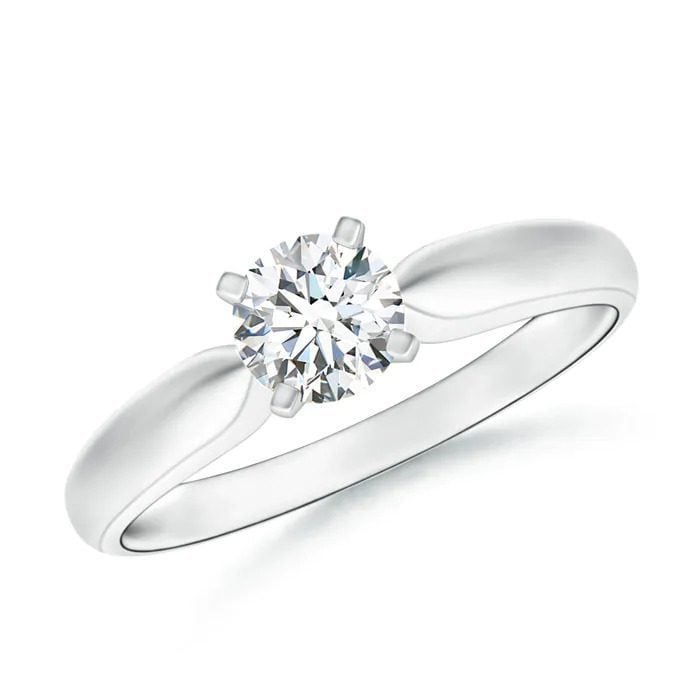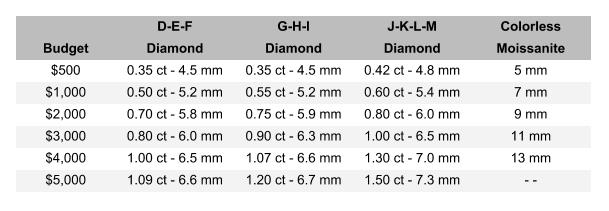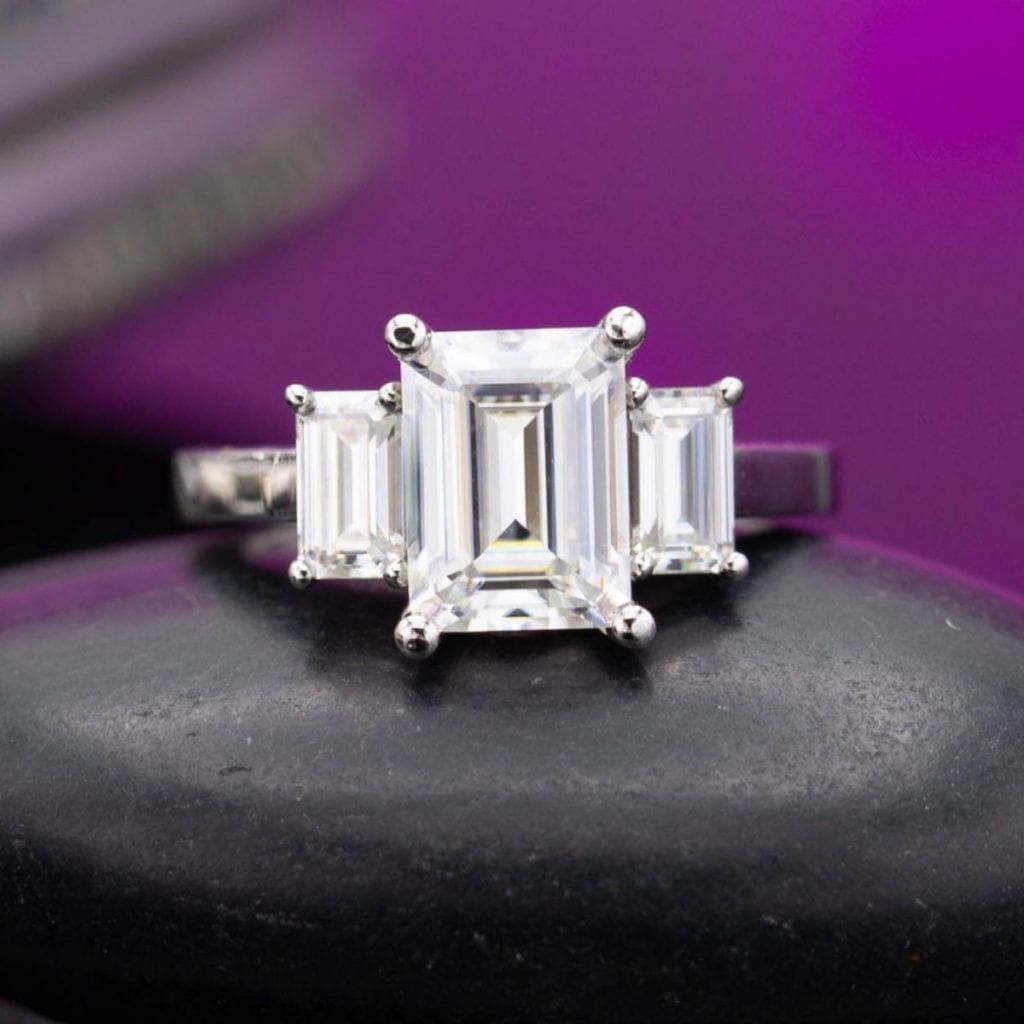Moissanite vs Diamond: Beauty, Durability, and Price
Moissanite vs Diamond: Which is More Beautiful? The top question in the moissanite vs diamond debate is whether one holds more beauty than the other. Certainly, moissanite is a convincing diamond simulant. To tell the difference between diamonds and moissanites, jewelry experts need a “moissanite tester” — a device that measures electrical conductivity — and a loupe for a close visual examination. However, there are slight differences in their beauty that consumers may notice.
Brilliance and Fire- When you’re looking at a diamond, you’ll notice both brilliance (white flashes) and fire (colored flashes). Moissanite also shows both, but typically has more fire than diamond. So, moissanite tends to have more colored flashes of light than diamond.
However, this depends partly on the diamond cut. Diamonds with older cut styles or modern cuts with certain angles will show more fire than most modern diamonds. This can make it difficult to tell the difference between the two.
 Distinguishing moissanites and diamonds based on brilliance and fire isn’t reliable, but it’s easier to see at larger sizes. Even so, unless you have experience in the jewelry industry, you won’t be able to tell the difference just based on appearance.
Distinguishing moissanites and diamonds based on brilliance and fire isn’t reliable, but it’s easier to see at larger sizes. Even so, unless you have experience in the jewelry industry, you won’t be able to tell the difference just based on appearance.
Color– Today, you can readily find moissanites in the same range of color as white diamonds. This wasn’t always the case.
“Classic” moissanite has a yellowish or brownish color, often compared to J through M color diamond. This range works best with yellow gold or rose gold settings and vintage styles.
However, moissanite is also available in colors equivalent to “Near Colorless” G to I range and “Colorless” D through F range. This gives moissanite buyers great options for mimicking their favorite diamond looks and styles.
Still, moissanite can change color based on lighting and may not always look perfectly colorless. Some stones will appear more yellow or yellow-green. Those sensitive to color may prefer diamond or white sapphire to moissanite.
Clarity: Because moissanites are grown in laboratories, they don’t have the large clarity imperfections that diamonds may contain. So, a moissanite will always be eye-clean, while diamonds may contain imperfections visible to the eye.
For those with low budgets, finding an eye-clean diamond in their desired size can be difficult. It involves examining many diamonds very closely. This can be time consuming and may require expert help.
Is Diamond More Durable Than Moissanite?
Hardness: At a 10 on the Mohs scale, diamond is well-known as the hardest material. Nothing but a diamond can scratch another diamond. With a hardness of 9.25, moissanite is the second-hardest material used a gemstone. Unless you store your moissanite with diamond jewelry, it’s highly unlikely that it will scratch.
Toughness: However, determining whether moissanite or diamond makes a tougher gem material is difficult. People who sell moissanite may claim moissanite is tougher, while those who sell diamond may claim the opposite.
Moissanite doesn’t have a cleavage plane, while diamond does. (This is an internal plane along which a diamond crystal can easily split). This gives a durability advantage to moissanite. However, this doesn’t help establish how hard a moissanite needs to be knocked until it chips or shatters.
The IGS cannot corroborate the following measurements of pressure tolerance in millions of pounds per square inch (PSI) for diamond, moissanite, and cubic zirconia (CZ), another well-known diamond simulant. However, they may give some basis for comparison:
- Diamond: 14.6 PSI
- Moissanite: 7.6 PSI
- CZ: 2.4 PSI
If reliable, these figures indicate diamond takes about twice as much pressure to break than moissanite, while moissanite takes three times as much pressure to break than CZ. However, it’s not clear if the measurement for diamond is an average of pressure applied in any direction or if it was taken along its cleavage plane, which would be weaker. (CZ, like moissanite, also lacks a cleavage plane).
Generally, both diamond and moissanite are unlikely to chip or crack, although this is always a possibility and also depends on the type of cut. (For example, princess cuts may chip more easily than rounds). When choosing between these gems, durability isn’t a significant factor.
Budget and Size for Moissanite vs. Diamond: Cost is almost always a major factor when choosing an engagement ring. When comparing moissanite vs diamond, moissanite is the clear winner in the price category. Check out the moissanite sizes you can get for the following budgets, compared to diamonds of different color grades.
 .
.For simplicity’s sake, these are prices for round diamonds, with the highest carat weight in the budget for an eye-clean SI2, excellent-cut diamond from James Allen. These diamond prices represent a bare minimum of eye-clean quality. Moissanite sizes are taken from Brilliant Earth’s Super Premium moissanite, which is equivalent to a D-E-F diamond color grade.
As you can see, moissanite offers major cost savings. Even spending under $1,000, you can get a stone the size of a one-carat diamond. For a diamond this size, you’d pay at least $3,000, with significant compromises in color and clarity. If you spent that much on a moissanite it would be huge, over 1 cm across!
Even at smaller budgets of $500, the size difference between moissanite and diamond is significant, with a moissanite being 8% larger than a diamond with faint color or 20% larger than a D-E-F diamond.
Natural Origins or Lab-Made Beauty? Ultimately, the most important factor in your decision on moissanite vs diamond — even more so than cost — will be whether you’d just prefer to have a diamond or a moissanite.
Some consumers prefer diamond for tradition, prestige, or natural origin. Others prefer moissanite for sustainability or ethical reasons, or simply because they can get the aesthetic they desire for less. This is a personal choice with no wrong answers. If you’d prefer a diamond, buy a diamond. If you’d prefer a moissanite, buy a moissanite.
Where to Purchase a Moissanite or Diamond Engagement Ring: If you’ve decided on a diamond, read about diamond quality first to avoid paying more than necessary. Because a diamond is such an expensive and personal purchase, you simply must get a closeup look at how it sparkles before buying. To get the most for your money, we recommend using online dealers like James Allen and Blue Nile. Both provide 360° video of their diamonds and plenty of ring settings to choose from. With their extensive selections of diamonds, you’re sure to find the one that’s best for you.
If you just can’t seem to find the right engagement ring style, try contacting the experts at CustomMade. Whether diamond, moissanite, or something else entirely, Custom-made will help you find the perfect center stone for your style and budget and place it in a unique engagement ring you’ll cherish.
